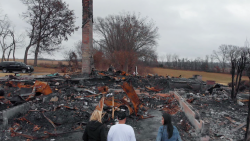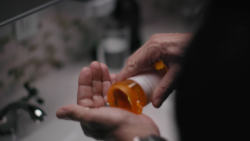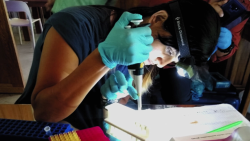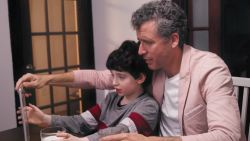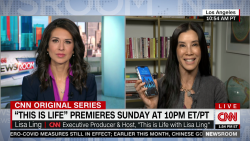Editor’s Note: Dr. Craig Heacock is an adolescent and adult psychiatrist and addiction specialist in Colorado who hosts the psychiatric storytelling podcast “Back from the Abyss.” He is a co-therapist in the Phase 3 trial of MDMA-Assisted Psychotherapy for PTSD and has particular interest in the use of psychedelics to treat severe mood disorders and PTSD. The use of psychedelic drugs is still under research; please consult with your physician before starting any treatment. The views expressed here are his own. Learn more about his work on “This Is Life with Lisa Ling” tonight at 10 p.m. ET/PT.
It’s said that science progresses “one gravestone at a time,” since major changes in theoretical perspective usually require a new generation or more to take hold.
Psychiatry, in contrast, is in the midst of a massive shift: We’re experiencing a veritable psychedelic revolution, as drugs like MDMA, psilocybin and ketamine offer new hope for treating severe mental anguish.
I’ve been a psychiatrist for 15 years, and I have long recognized that there is a significant percentage of patients for whom we have never been able to offer meaningful relief. In my experience, these are largely patients with extensive trauma histories, such as childhood abuse and neglect. Trauma, as the root of so much psychological distress, is the great imitator: It can present as depression; suicidal thinking; self-harm; dissociation or numbing; substance abuse; panic; an eating disorder; or even impulsive aggression.
Psychiatry and mental health treatment have traditionally focused on talk therapy and medications, interventions which are often quite helpful at relieving many types of psychological distress. Yet I never truly understood why we couldn’t successfully talk or medicate some of our patients out of their trauma until I began to work with psychedelics in 2017. I’m finding that my entire perspective on healing trauma is rapidly changing, one psychedelic session at a time.
Psychedelics, which include a broad range of substances that tweak the dials of consciousness in very different ways, initially suggested great promise as medicinal treatments for mental health disorders in the 1950s and ’60s. Drug prohibition in the following decades pushed them underground, and these drugs were then largely ignored by the psychiatric establishment until a resurgence in exploration in the 1990s.
The psychedelic treatment revolution taking place today arguably started in 2006, with Carlos Zarate’s JAMA paper suggesting the unexpected efficacy of the anesthetic ketamine for depressed and suicidal patients.
Now ketamine – which you may know by the street name “Special K” – is widely available across the United States for medicinal use, and it’s becoming an indispensable part of depression treatment. Two other psychedelics, MDMA and psilocybin, are in Phase 3 and Phase 2 clinical trials, and could be approved within the next couple of years for treatment of PTSD and depression.
I have always been a materialist – a “show me the evidence” sort of person. I’ve been deeply curious about an energetic or spiritual element that would affect a person’s overall health, but it always seemed a little woo-woo and unscientific to merit much attention. In my residency program, for example, we never considered that trauma might be held in the body, much less in the spirit. Yet it is now becoming clear through psychedelic psychotherapy research that trauma is held both in the body and in a person’s spirit – or life energy, or primary consciousness, whatever one might label it.
Herein lies the reason why so many people suffering from depression and anxiety, addiction, and/or profound psychological despair have found their mental health struggles to be so resistant to treatment: I believe these disorders are more often than not tied to a deep, and largely untouchable, river of trauma that lies beneath our reach in the unconscious mind.
Somatic trauma therapists, who primarily focus on feelings and perceptions in the body, have long used this knowledge to bypass the verbal, analytical ego and access stored trauma in the tissues. But the process of somatic therapy can be slow, arduous and even painful, as therapist and patient struggle to reach that which is deepest and most hidden in our body and psyche.
Psychedelic treatment, meanwhile, appears to be a less painful portal to accessing the interface of the unconscious and the body. This is profoundly difficult to explain but easy to witness in the treatment room, as people are able to open up and explore previously unreachable wounds, perceptions and insights.
I discovered this during my first experience with using psychedelics to treat deep-seated trauma, when I joined a MAPS-sponsored study of MDMA-assisted psychotherapy for post-traumatic stress disorder (PTSD). As a co-therapist in those sessions, I observed patients being able to mentally return to the source of the trauma and begin to rework and reframe their experience without fear. Using pharmaceutical-grade doses of MDMA alongside psychotherapy sessions, they were able to process what happened with the warm light of compassion, pushing away the toxic sludge of shame that surrounded the trauma.
MDMA, better known by its street names of “Ecstasy” or “Molly,” is a Schedule 1 illegal drug that, prior to its prohibition in 1985, was used by some psychotherapists to help their clients work through trauma and other psychological issues. The nonprofit MAPS – which stands for Multidisciplinary Association for Psychedelic Studies – was founded shortly after MDMA’s criminalization, with the goal of making MDMA again available for research and treatment.
So far, the work has shown promise: 68% of participants in the Phase 2 MAPS clinical trials no longer met the criteria for PTSD a full year after receiving treatment. In 2017, the FDA gave MDMA a breakthrough therapy designation, meaning the results of early clinical research indicated potential for a substantially improved treatment for severe PTSD.
We don’t fully understand why MDMA is so effective at fostering trust and empathy while also dialing down fear, but one mechanism might involve the inhibition of specific circuits in the amygdala, the fear node of the brain. There’s more research to be done, and MDMA is not yet available for patients outside of research studies.
The psychedelic ketamine, however, is available now, and I use it extensively within my own practice – it’s hard for me to remember how I even practiced without it. A 50-year-old general anesthetic, ketamine has been successfully repurposed over the past few years to treat depression and PTSD. Although low – as in non-psychedelic – doses of ketamine appear helpful for depression, I and many other physicians are finding that the fully dissociative psychedelic doses of ketamine appear to be the most powerfully effective. While the lower doses do improve mood and energy for many, they typically don’t touch the somatic-spiritual, or unconscious, interface where we’ve found trauma to lurk.
Get our free weekly newsletter
In these higher psychedelic dosage treatments, I often see hidden rivers of trauma come to the surface, where the patient and I can begin to explore the heretofore unspeakable and unknowable. Most of who we are lies in the unconscious, and with severe trauma the unconscious is where the healing needs to start.
Psychedelics including MDMA, psilocybin, THC (yes, THC!), ayahuasca and ketamine, when prescribed under the care of a medical professional in combination with psychotherapy, are opening up rapid access to these realms that have been so difficult to reach and understand. And once this access has been established, we are finding that patients are healing with intermittent treatments, often spaced over months or longer, in contrast with standard psychiatric medications, which are dosed daily or even multiple times a day. Psilocybin, a compound found in “magic mushrooms,” has been found to reduce symptoms for depression, anxiety and obsessive compulsive disorder, while the South American brew ayahuasca has been shown to be effective as a treatment for severe depression.
Psychiatry might be moving to a model where many patients do intermittent psychedelic treatments, interspersed by both talk and somatic therapies, and thus moving away from daily medications for symptom management. At the least, psychedelics are finally giving us a chance to help traumatized patients and their treatment resistant mood and anxiety symptoms.


